Should ASEAN Adopt a Common Currency Like the Euro? A Report
VerifiedAdded on 2020/05/11
|9
|2465
|75
Report
AI Summary
This report provides a comprehensive analysis of the potential for ASEAN countries to adopt a common currency, drawing parallels to the Eurozone's experience. It begins with an introduction to the concept of a common currency and its application in the EU, particularly the creation and structure of the Euro. The report delves into the critical analysis of ASEAN countries adopting a common currency, examining the creation and structure of the Euro, the pros and cons of the EU, and the potential benefits such as trade integration, reduced transaction costs, and price stability. It also considers the challenges ASEAN might face, including economic disparities and the complexities observed within the Eurozone. The report concludes with a balanced assessment of whether ASEAN should adopt a common currency like the Euro, emphasizing the need for careful consideration of both costs and benefits and the importance of achieving an optimal currency area. It also highlights the importance of studying the Eurozone's successes and failures to make an informed decision.
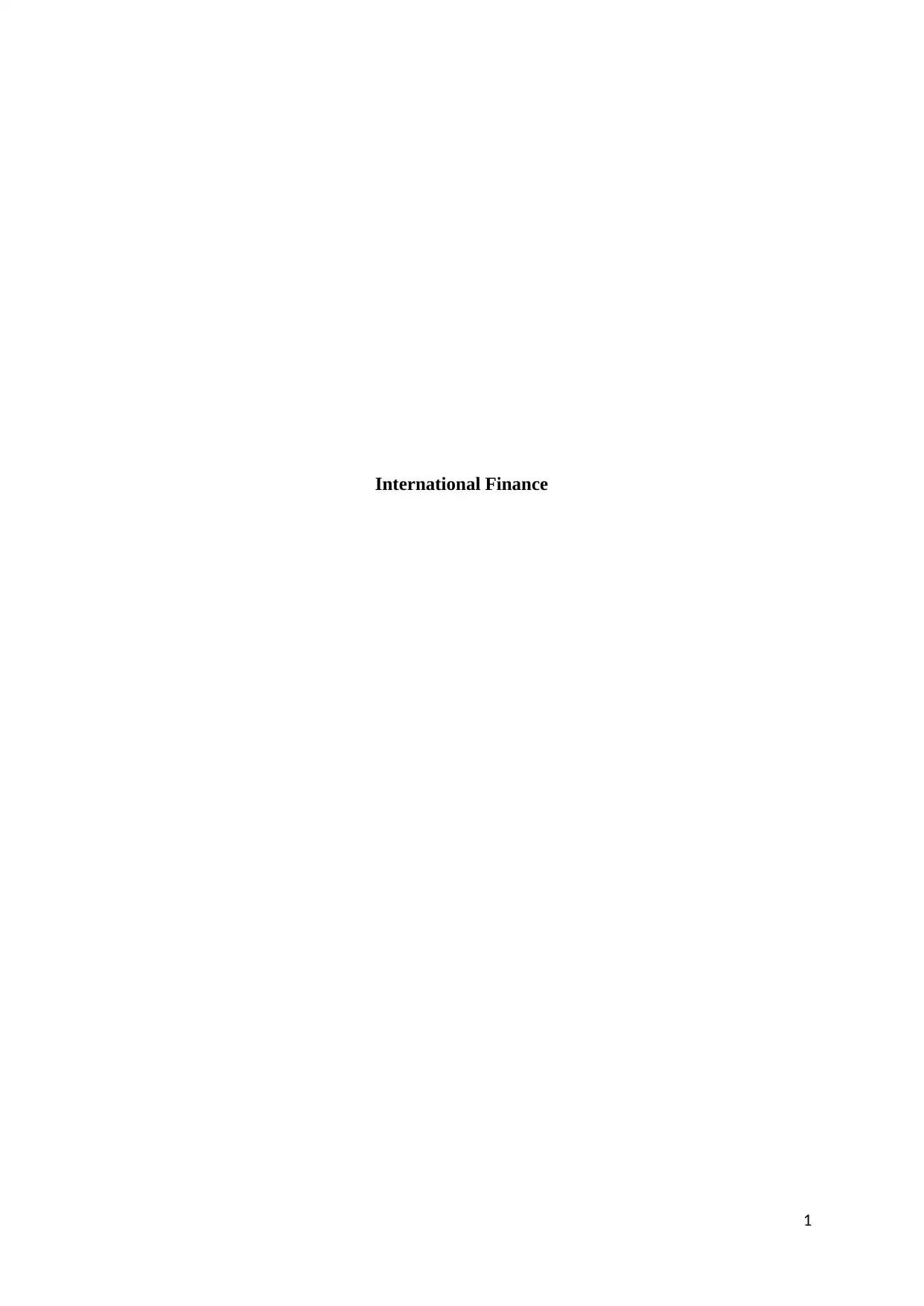
International Finance
1
1
Paraphrase This Document
Need a fresh take? Get an instant paraphrase of this document with our AI Paraphraser
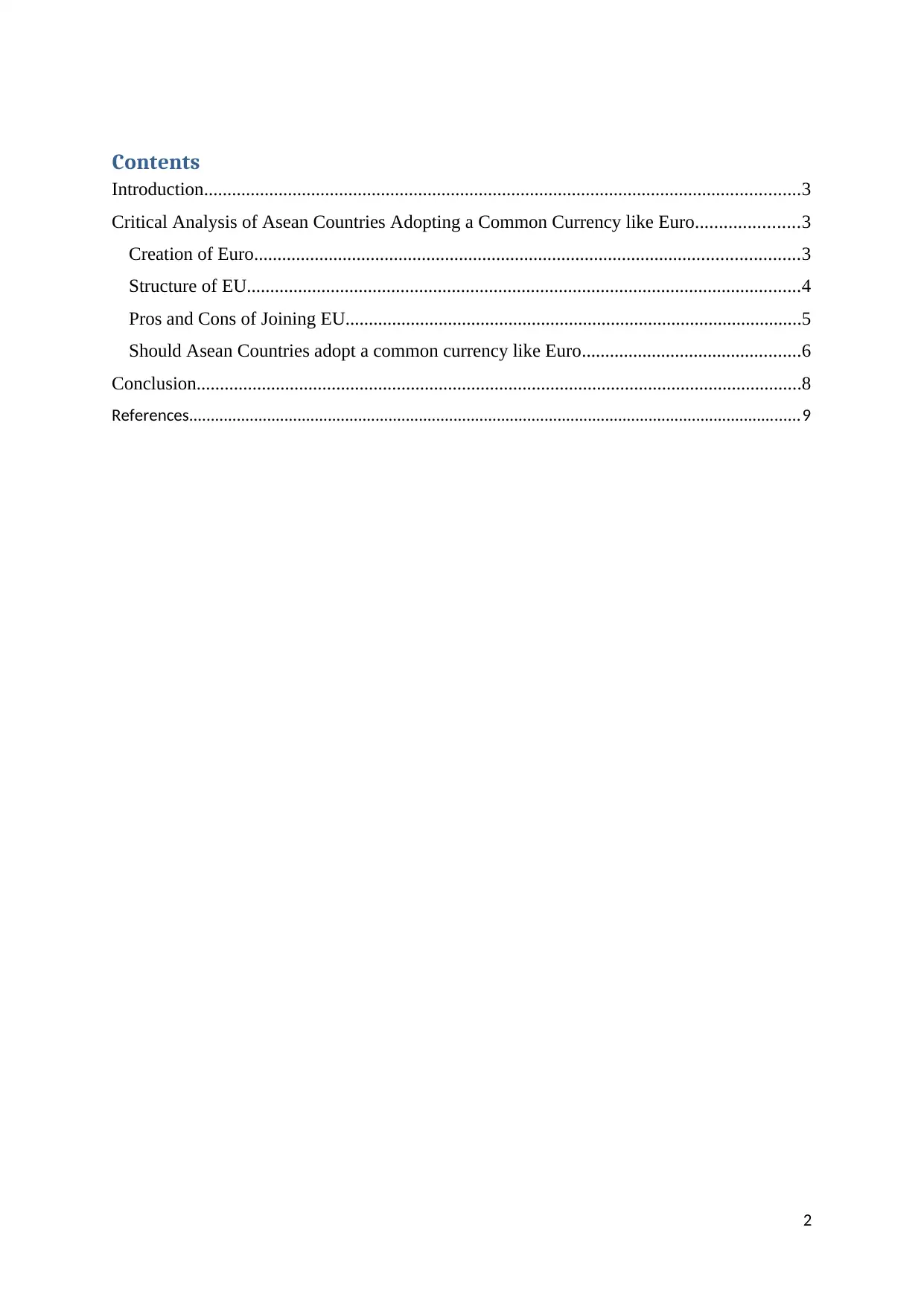
Contents
Introduction................................................................................................................................3
Critical Analysis of Asean Countries Adopting a Common Currency like Euro......................3
Creation of Euro.....................................................................................................................3
Structure of EU.......................................................................................................................4
Pros and Cons of Joining EU..................................................................................................5
Should Asean Countries adopt a common currency like Euro...............................................6
Conclusion..................................................................................................................................8
References.............................................................................................................................................9
2
Introduction................................................................................................................................3
Critical Analysis of Asean Countries Adopting a Common Currency like Euro......................3
Creation of Euro.....................................................................................................................3
Structure of EU.......................................................................................................................4
Pros and Cons of Joining EU..................................................................................................5
Should Asean Countries adopt a common currency like Euro...............................................6
Conclusion..................................................................................................................................8
References.............................................................................................................................................9
2
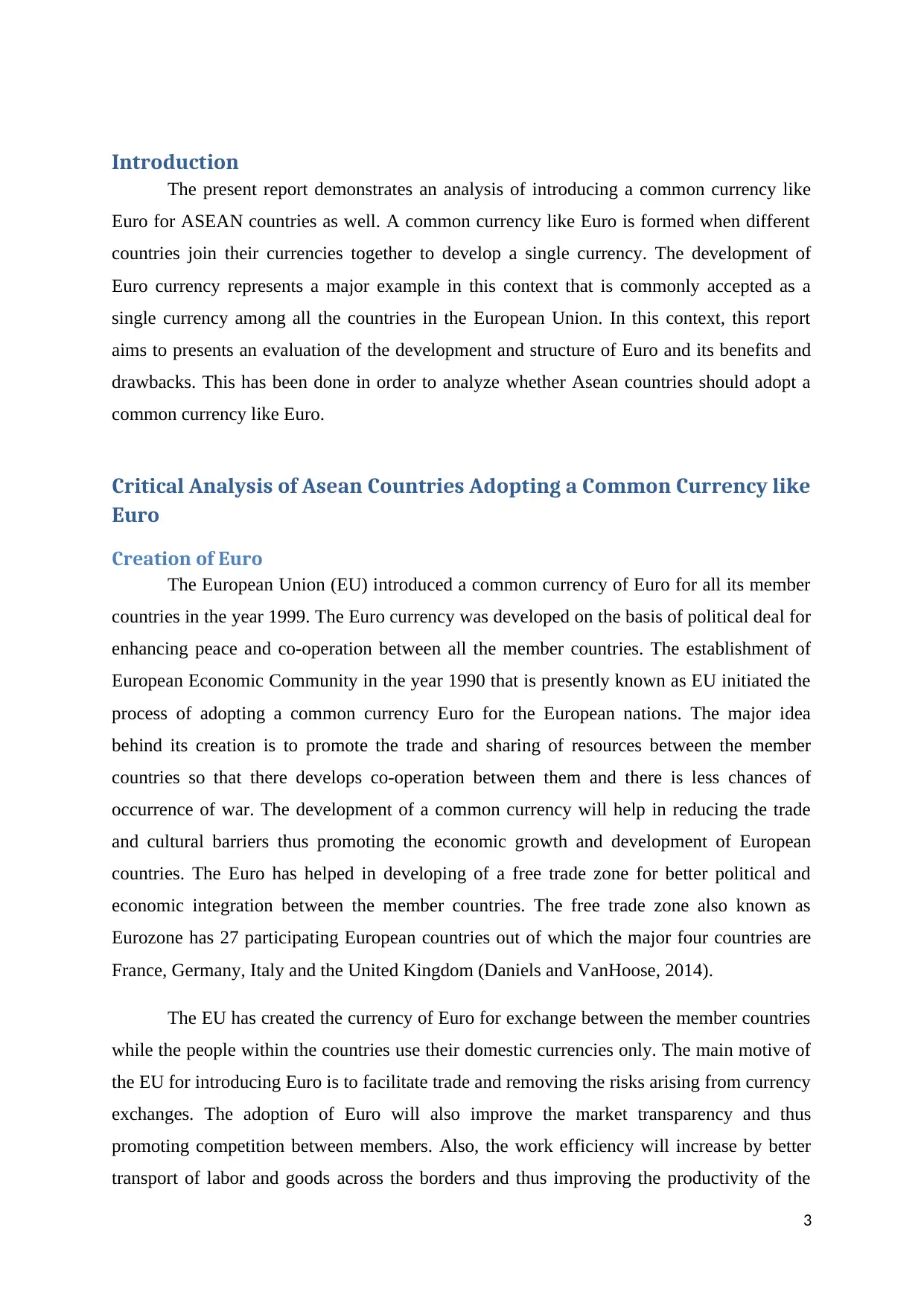
Introduction
The present report demonstrates an analysis of introducing a common currency like
Euro for ASEAN countries as well. A common currency like Euro is formed when different
countries join their currencies together to develop a single currency. The development of
Euro currency represents a major example in this context that is commonly accepted as a
single currency among all the countries in the European Union. In this context, this report
aims to presents an evaluation of the development and structure of Euro and its benefits and
drawbacks. This has been done in order to analyze whether Asean countries should adopt a
common currency like Euro.
Critical Analysis of Asean Countries Adopting a Common Currency like
Euro
Creation of Euro
The European Union (EU) introduced a common currency of Euro for all its member
countries in the year 1999. The Euro currency was developed on the basis of political deal for
enhancing peace and co-operation between all the member countries. The establishment of
European Economic Community in the year 1990 that is presently known as EU initiated the
process of adopting a common currency Euro for the European nations. The major idea
behind its creation is to promote the trade and sharing of resources between the member
countries so that there develops co-operation between them and there is less chances of
occurrence of war. The development of a common currency will help in reducing the trade
and cultural barriers thus promoting the economic growth and development of European
countries. The Euro has helped in developing of a free trade zone for better political and
economic integration between the member countries. The free trade zone also known as
Eurozone has 27 participating European countries out of which the major four countries are
France, Germany, Italy and the United Kingdom (Daniels and VanHoose, 2014).
The EU has created the currency of Euro for exchange between the member countries
while the people within the countries use their domestic currencies only. The main motive of
the EU for introducing Euro is to facilitate trade and removing the risks arising from currency
exchanges. The adoption of Euro will also improve the market transparency and thus
promoting competition between members. Also, the work efficiency will increase by better
transport of labor and goods across the borders and thus improving the productivity of the
3
The present report demonstrates an analysis of introducing a common currency like
Euro for ASEAN countries as well. A common currency like Euro is formed when different
countries join their currencies together to develop a single currency. The development of
Euro currency represents a major example in this context that is commonly accepted as a
single currency among all the countries in the European Union. In this context, this report
aims to presents an evaluation of the development and structure of Euro and its benefits and
drawbacks. This has been done in order to analyze whether Asean countries should adopt a
common currency like Euro.
Critical Analysis of Asean Countries Adopting a Common Currency like
Euro
Creation of Euro
The European Union (EU) introduced a common currency of Euro for all its member
countries in the year 1999. The Euro currency was developed on the basis of political deal for
enhancing peace and co-operation between all the member countries. The establishment of
European Economic Community in the year 1990 that is presently known as EU initiated the
process of adopting a common currency Euro for the European nations. The major idea
behind its creation is to promote the trade and sharing of resources between the member
countries so that there develops co-operation between them and there is less chances of
occurrence of war. The development of a common currency will help in reducing the trade
and cultural barriers thus promoting the economic growth and development of European
countries. The Euro has helped in developing of a free trade zone for better political and
economic integration between the member countries. The free trade zone also known as
Eurozone has 27 participating European countries out of which the major four countries are
France, Germany, Italy and the United Kingdom (Daniels and VanHoose, 2014).
The EU has created the currency of Euro for exchange between the member countries
while the people within the countries use their domestic currencies only. The main motive of
the EU for introducing Euro is to facilitate trade and removing the risks arising from currency
exchanges. The adoption of Euro will also improve the market transparency and thus
promoting competition between members. Also, the work efficiency will increase by better
transport of labor and goods across the borders and thus improving the productivity of the
3
⊘ This is a preview!⊘
Do you want full access?
Subscribe today to unlock all pages.

Trusted by 1+ million students worldwide
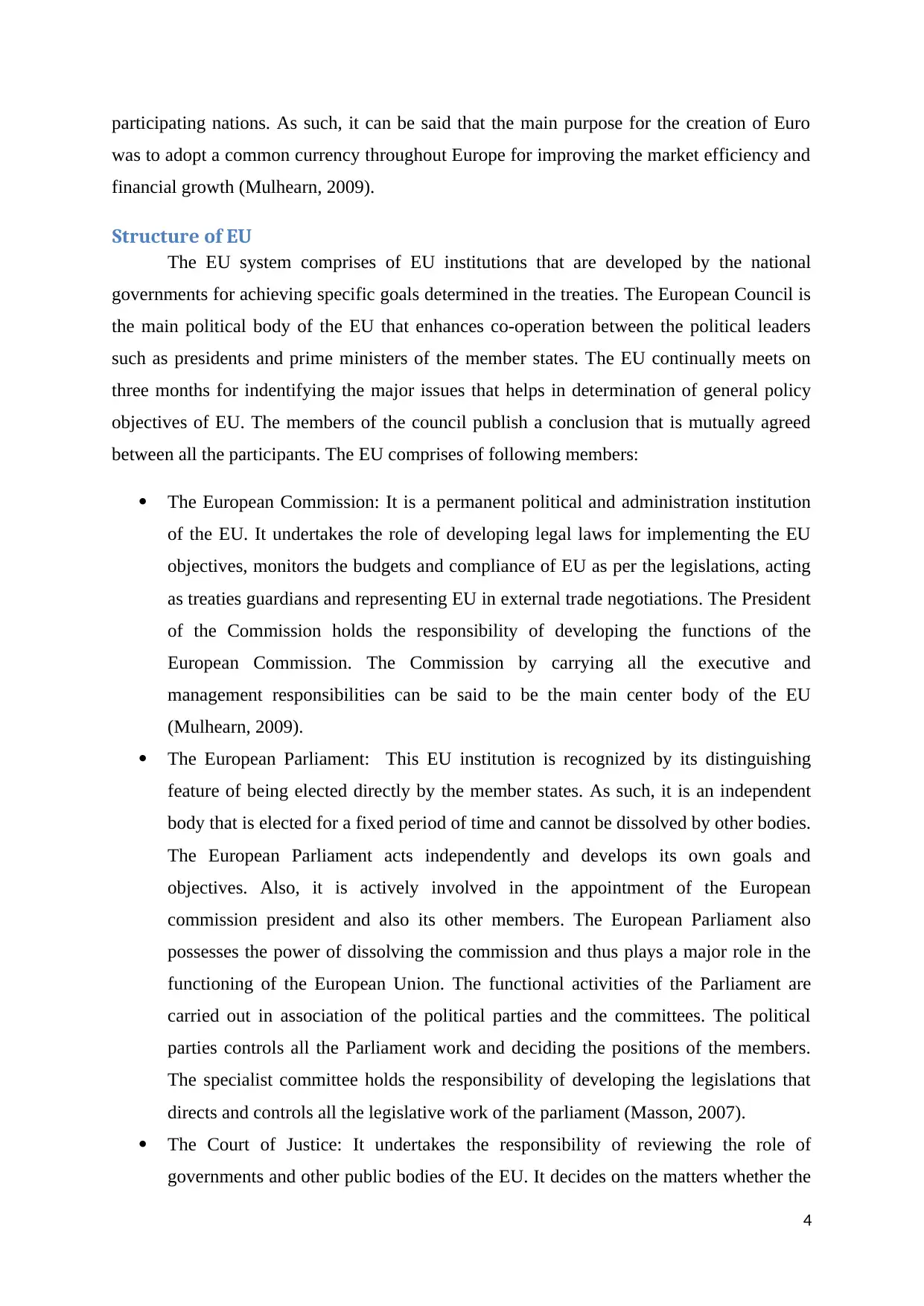
participating nations. As such, it can be said that the main purpose for the creation of Euro
was to adopt a common currency throughout Europe for improving the market efficiency and
financial growth (Mulhearn, 2009).
Structure of EU
The EU system comprises of EU institutions that are developed by the national
governments for achieving specific goals determined in the treaties. The European Council is
the main political body of the EU that enhances co-operation between the political leaders
such as presidents and prime ministers of the member states. The EU continually meets on
three months for indentifying the major issues that helps in determination of general policy
objectives of EU. The members of the council publish a conclusion that is mutually agreed
between all the participants. The EU comprises of following members:
The European Commission: It is a permanent political and administration institution
of the EU. It undertakes the role of developing legal laws for implementing the EU
objectives, monitors the budgets and compliance of EU as per the legislations, acting
as treaties guardians and representing EU in external trade negotiations. The President
of the Commission holds the responsibility of developing the functions of the
European Commission. The Commission by carrying all the executive and
management responsibilities can be said to be the main center body of the EU
(Mulhearn, 2009).
The European Parliament: This EU institution is recognized by its distinguishing
feature of being elected directly by the member states. As such, it is an independent
body that is elected for a fixed period of time and cannot be dissolved by other bodies.
The European Parliament acts independently and develops its own goals and
objectives. Also, it is actively involved in the appointment of the European
commission president and also its other members. The European Parliament also
possesses the power of dissolving the commission and thus plays a major role in the
functioning of the European Union. The functional activities of the Parliament are
carried out in association of the political parties and the committees. The political
parties controls all the Parliament work and deciding the positions of the members.
The specialist committee holds the responsibility of developing the legislations that
directs and controls all the legislative work of the parliament (Masson, 2007).
The Court of Justice: It undertakes the responsibility of reviewing the role of
governments and other public bodies of the EU. It decides on the matters whether the
4
was to adopt a common currency throughout Europe for improving the market efficiency and
financial growth (Mulhearn, 2009).
Structure of EU
The EU system comprises of EU institutions that are developed by the national
governments for achieving specific goals determined in the treaties. The European Council is
the main political body of the EU that enhances co-operation between the political leaders
such as presidents and prime ministers of the member states. The EU continually meets on
three months for indentifying the major issues that helps in determination of general policy
objectives of EU. The members of the council publish a conclusion that is mutually agreed
between all the participants. The EU comprises of following members:
The European Commission: It is a permanent political and administration institution
of the EU. It undertakes the role of developing legal laws for implementing the EU
objectives, monitors the budgets and compliance of EU as per the legislations, acting
as treaties guardians and representing EU in external trade negotiations. The President
of the Commission holds the responsibility of developing the functions of the
European Commission. The Commission by carrying all the executive and
management responsibilities can be said to be the main center body of the EU
(Mulhearn, 2009).
The European Parliament: This EU institution is recognized by its distinguishing
feature of being elected directly by the member states. As such, it is an independent
body that is elected for a fixed period of time and cannot be dissolved by other bodies.
The European Parliament acts independently and develops its own goals and
objectives. Also, it is actively involved in the appointment of the European
commission president and also its other members. The European Parliament also
possesses the power of dissolving the commission and thus plays a major role in the
functioning of the European Union. The functional activities of the Parliament are
carried out in association of the political parties and the committees. The political
parties controls all the Parliament work and deciding the positions of the members.
The specialist committee holds the responsibility of developing the legislations that
directs and controls all the legislative work of the parliament (Masson, 2007).
The Court of Justice: It undertakes the responsibility of reviewing the role of
governments and other public bodies of the EU. It decides on the matters whether the
4
Paraphrase This Document
Need a fresh take? Get an instant paraphrase of this document with our AI Paraphraser
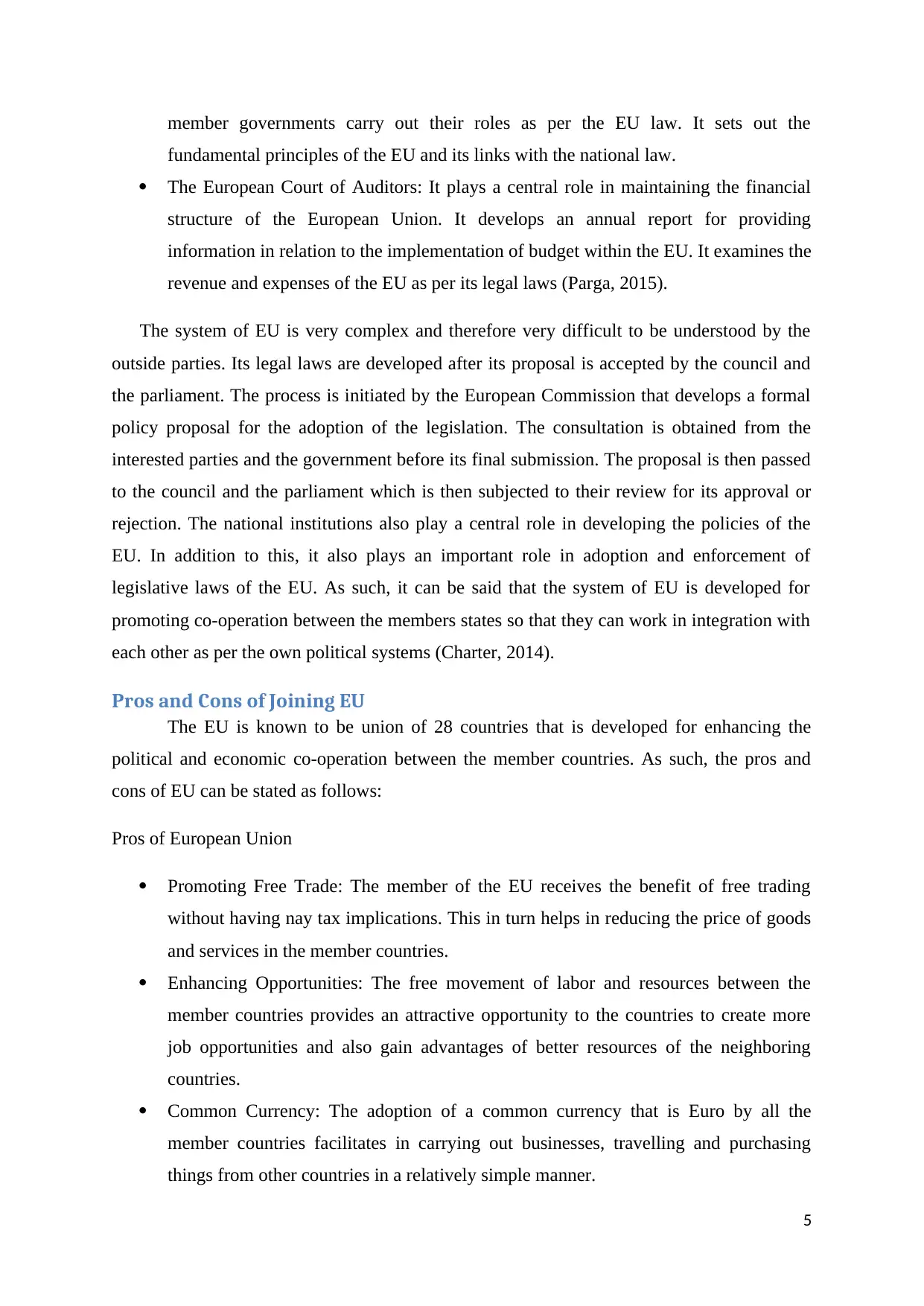
member governments carry out their roles as per the EU law. It sets out the
fundamental principles of the EU and its links with the national law.
The European Court of Auditors: It plays a central role in maintaining the financial
structure of the European Union. It develops an annual report for providing
information in relation to the implementation of budget within the EU. It examines the
revenue and expenses of the EU as per its legal laws (Parga, 2015).
The system of EU is very complex and therefore very difficult to be understood by the
outside parties. Its legal laws are developed after its proposal is accepted by the council and
the parliament. The process is initiated by the European Commission that develops a formal
policy proposal for the adoption of the legislation. The consultation is obtained from the
interested parties and the government before its final submission. The proposal is then passed
to the council and the parliament which is then subjected to their review for its approval or
rejection. The national institutions also play a central role in developing the policies of the
EU. In addition to this, it also plays an important role in adoption and enforcement of
legislative laws of the EU. As such, it can be said that the system of EU is developed for
promoting co-operation between the members states so that they can work in integration with
each other as per the own political systems (Charter, 2014).
Pros and Cons of Joining EU
The EU is known to be union of 28 countries that is developed for enhancing the
political and economic co-operation between the member countries. As such, the pros and
cons of EU can be stated as follows:
Pros of European Union
Promoting Free Trade: The member of the EU receives the benefit of free trading
without having nay tax implications. This in turn helps in reducing the price of goods
and services in the member countries.
Enhancing Opportunities: The free movement of labor and resources between the
member countries provides an attractive opportunity to the countries to create more
job opportunities and also gain advantages of better resources of the neighboring
countries.
Common Currency: The adoption of a common currency that is Euro by all the
member countries facilitates in carrying out businesses, travelling and purchasing
things from other countries in a relatively simple manner.
5
fundamental principles of the EU and its links with the national law.
The European Court of Auditors: It plays a central role in maintaining the financial
structure of the European Union. It develops an annual report for providing
information in relation to the implementation of budget within the EU. It examines the
revenue and expenses of the EU as per its legal laws (Parga, 2015).
The system of EU is very complex and therefore very difficult to be understood by the
outside parties. Its legal laws are developed after its proposal is accepted by the council and
the parliament. The process is initiated by the European Commission that develops a formal
policy proposal for the adoption of the legislation. The consultation is obtained from the
interested parties and the government before its final submission. The proposal is then passed
to the council and the parliament which is then subjected to their review for its approval or
rejection. The national institutions also play a central role in developing the policies of the
EU. In addition to this, it also plays an important role in adoption and enforcement of
legislative laws of the EU. As such, it can be said that the system of EU is developed for
promoting co-operation between the members states so that they can work in integration with
each other as per the own political systems (Charter, 2014).
Pros and Cons of Joining EU
The EU is known to be union of 28 countries that is developed for enhancing the
political and economic co-operation between the member countries. As such, the pros and
cons of EU can be stated as follows:
Pros of European Union
Promoting Free Trade: The member of the EU receives the benefit of free trading
without having nay tax implications. This in turn helps in reducing the price of goods
and services in the member countries.
Enhancing Opportunities: The free movement of labor and resources between the
member countries provides an attractive opportunity to the countries to create more
job opportunities and also gain advantages of better resources of the neighboring
countries.
Common Currency: The adoption of a common currency that is Euro by all the
member countries facilitates in carrying out businesses, travelling and purchasing
things from other countries in a relatively simple manner.
5
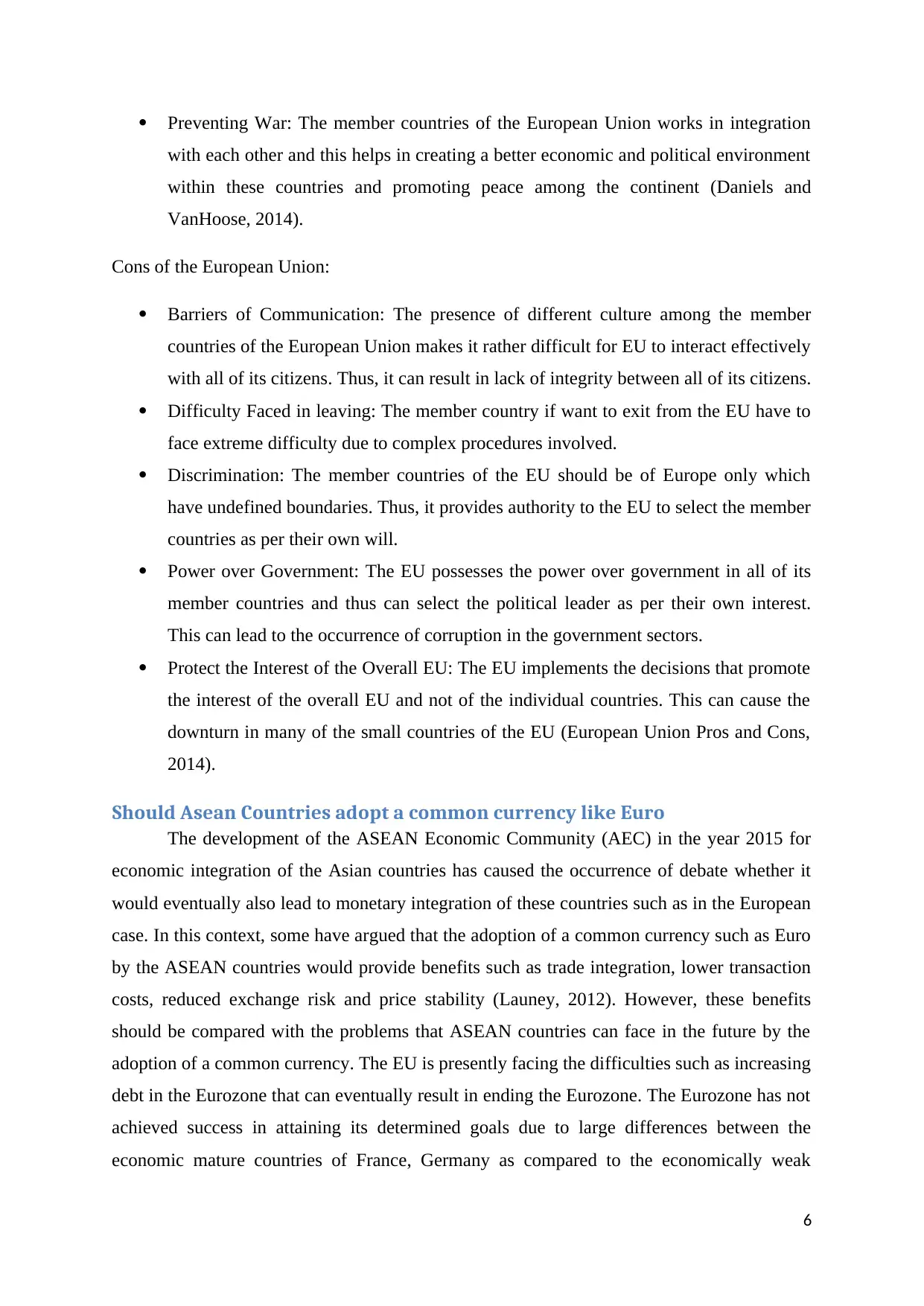
Preventing War: The member countries of the European Union works in integration
with each other and this helps in creating a better economic and political environment
within these countries and promoting peace among the continent (Daniels and
VanHoose, 2014).
Cons of the European Union:
Barriers of Communication: The presence of different culture among the member
countries of the European Union makes it rather difficult for EU to interact effectively
with all of its citizens. Thus, it can result in lack of integrity between all of its citizens.
Difficulty Faced in leaving: The member country if want to exit from the EU have to
face extreme difficulty due to complex procedures involved.
Discrimination: The member countries of the EU should be of Europe only which
have undefined boundaries. Thus, it provides authority to the EU to select the member
countries as per their own will.
Power over Government: The EU possesses the power over government in all of its
member countries and thus can select the political leader as per their own interest.
This can lead to the occurrence of corruption in the government sectors.
Protect the Interest of the Overall EU: The EU implements the decisions that promote
the interest of the overall EU and not of the individual countries. This can cause the
downturn in many of the small countries of the EU (European Union Pros and Cons,
2014).
Should Asean Countries adopt a common currency like Euro
The development of the ASEAN Economic Community (AEC) in the year 2015 for
economic integration of the Asian countries has caused the occurrence of debate whether it
would eventually also lead to monetary integration of these countries such as in the European
case. In this context, some have argued that the adoption of a common currency such as Euro
by the ASEAN countries would provide benefits such as trade integration, lower transaction
costs, reduced exchange risk and price stability (Launey, 2012). However, these benefits
should be compared with the problems that ASEAN countries can face in the future by the
adoption of a common currency. The EU is presently facing the difficulties such as increasing
debt in the Eurozone that can eventually result in ending the Eurozone. The Eurozone has not
achieved success in attaining its determined goals due to large differences between the
economic mature countries of France, Germany as compared to the economically weak
6
with each other and this helps in creating a better economic and political environment
within these countries and promoting peace among the continent (Daniels and
VanHoose, 2014).
Cons of the European Union:
Barriers of Communication: The presence of different culture among the member
countries of the European Union makes it rather difficult for EU to interact effectively
with all of its citizens. Thus, it can result in lack of integrity between all of its citizens.
Difficulty Faced in leaving: The member country if want to exit from the EU have to
face extreme difficulty due to complex procedures involved.
Discrimination: The member countries of the EU should be of Europe only which
have undefined boundaries. Thus, it provides authority to the EU to select the member
countries as per their own will.
Power over Government: The EU possesses the power over government in all of its
member countries and thus can select the political leader as per their own interest.
This can lead to the occurrence of corruption in the government sectors.
Protect the Interest of the Overall EU: The EU implements the decisions that promote
the interest of the overall EU and not of the individual countries. This can cause the
downturn in many of the small countries of the EU (European Union Pros and Cons,
2014).
Should Asean Countries adopt a common currency like Euro
The development of the ASEAN Economic Community (AEC) in the year 2015 for
economic integration of the Asian countries has caused the occurrence of debate whether it
would eventually also lead to monetary integration of these countries such as in the European
case. In this context, some have argued that the adoption of a common currency such as Euro
by the ASEAN countries would provide benefits such as trade integration, lower transaction
costs, reduced exchange risk and price stability (Launey, 2012). However, these benefits
should be compared with the problems that ASEAN countries can face in the future by the
adoption of a common currency. The EU is presently facing the difficulties such as increasing
debt in the Eurozone that can eventually result in ending the Eurozone. The Eurozone has not
achieved success in attaining its determined goals due to large differences between the
economic mature countries of France, Germany as compared to the economically weak
6
⊘ This is a preview!⊘
Do you want full access?
Subscribe today to unlock all pages.

Trusted by 1+ million students worldwide
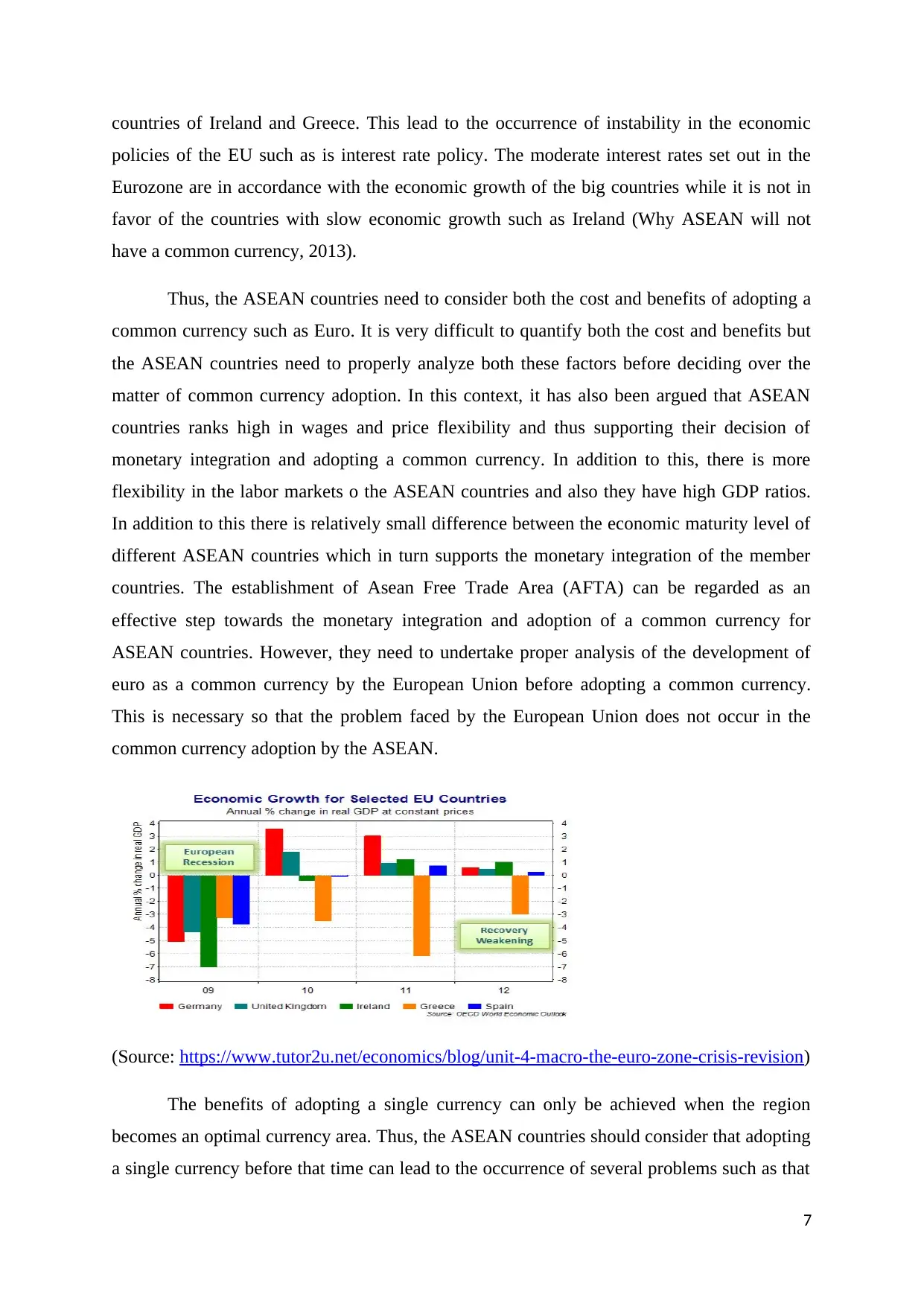
countries of Ireland and Greece. This lead to the occurrence of instability in the economic
policies of the EU such as is interest rate policy. The moderate interest rates set out in the
Eurozone are in accordance with the economic growth of the big countries while it is not in
favor of the countries with slow economic growth such as Ireland (Why ASEAN will not
have a common currency, 2013).
Thus, the ASEAN countries need to consider both the cost and benefits of adopting a
common currency such as Euro. It is very difficult to quantify both the cost and benefits but
the ASEAN countries need to properly analyze both these factors before deciding over the
matter of common currency adoption. In this context, it has also been argued that ASEAN
countries ranks high in wages and price flexibility and thus supporting their decision of
monetary integration and adopting a common currency. In addition to this, there is more
flexibility in the labor markets o the ASEAN countries and also they have high GDP ratios.
In addition to this there is relatively small difference between the economic maturity level of
different ASEAN countries which in turn supports the monetary integration of the member
countries. The establishment of Asean Free Trade Area (AFTA) can be regarded as an
effective step towards the monetary integration and adoption of a common currency for
ASEAN countries. However, they need to undertake proper analysis of the development of
euro as a common currency by the European Union before adopting a common currency.
This is necessary so that the problem faced by the European Union does not occur in the
common currency adoption by the ASEAN.
(Source: https://www.tutor2u.net/economics/blog/unit-4-macro-the-euro-zone-crisis-revision)
The benefits of adopting a single currency can only be achieved when the region
becomes an optimal currency area. Thus, the ASEAN countries should consider that adopting
a single currency before that time can lead to the occurrence of several problems such as that
7
policies of the EU such as is interest rate policy. The moderate interest rates set out in the
Eurozone are in accordance with the economic growth of the big countries while it is not in
favor of the countries with slow economic growth such as Ireland (Why ASEAN will not
have a common currency, 2013).
Thus, the ASEAN countries need to consider both the cost and benefits of adopting a
common currency such as Euro. It is very difficult to quantify both the cost and benefits but
the ASEAN countries need to properly analyze both these factors before deciding over the
matter of common currency adoption. In this context, it has also been argued that ASEAN
countries ranks high in wages and price flexibility and thus supporting their decision of
monetary integration and adopting a common currency. In addition to this, there is more
flexibility in the labor markets o the ASEAN countries and also they have high GDP ratios.
In addition to this there is relatively small difference between the economic maturity level of
different ASEAN countries which in turn supports the monetary integration of the member
countries. The establishment of Asean Free Trade Area (AFTA) can be regarded as an
effective step towards the monetary integration and adoption of a common currency for
ASEAN countries. However, they need to undertake proper analysis of the development of
euro as a common currency by the European Union before adopting a common currency.
This is necessary so that the problem faced by the European Union does not occur in the
common currency adoption by the ASEAN.
(Source: https://www.tutor2u.net/economics/blog/unit-4-macro-the-euro-zone-crisis-revision)
The benefits of adopting a single currency can only be achieved when the region
becomes an optimal currency area. Thus, the ASEAN countries should consider that adopting
a single currency before that time can lead to the occurrence of several problems such as that
7
Paraphrase This Document
Need a fresh take? Get an instant paraphrase of this document with our AI Paraphraser
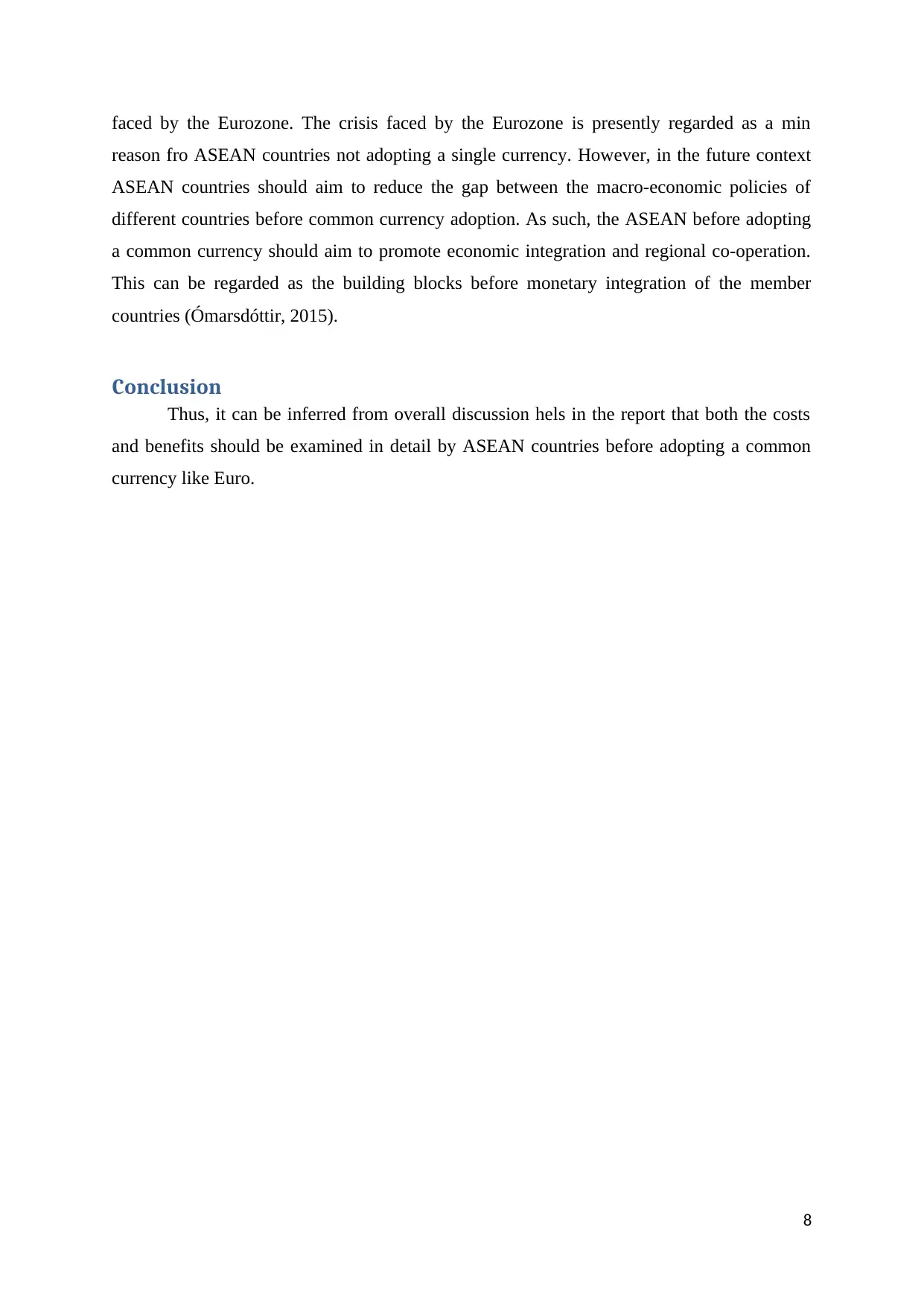
faced by the Eurozone. The crisis faced by the Eurozone is presently regarded as a min
reason fro ASEAN countries not adopting a single currency. However, in the future context
ASEAN countries should aim to reduce the gap between the macro-economic policies of
different countries before common currency adoption. As such, the ASEAN before adopting
a common currency should aim to promote economic integration and regional co-operation.
This can be regarded as the building blocks before monetary integration of the member
countries (Ómarsdóttir, 2015).
Conclusion
Thus, it can be inferred from overall discussion hels in the report that both the costs
and benefits should be examined in detail by ASEAN countries before adopting a common
currency like Euro.
8
reason fro ASEAN countries not adopting a single currency. However, in the future context
ASEAN countries should aim to reduce the gap between the macro-economic policies of
different countries before common currency adoption. As such, the ASEAN before adopting
a common currency should aim to promote economic integration and regional co-operation.
This can be regarded as the building blocks before monetary integration of the member
countries (Ómarsdóttir, 2015).
Conclusion
Thus, it can be inferred from overall discussion hels in the report that both the costs
and benefits should be examined in detail by ASEAN countries before adopting a common
currency like Euro.
8
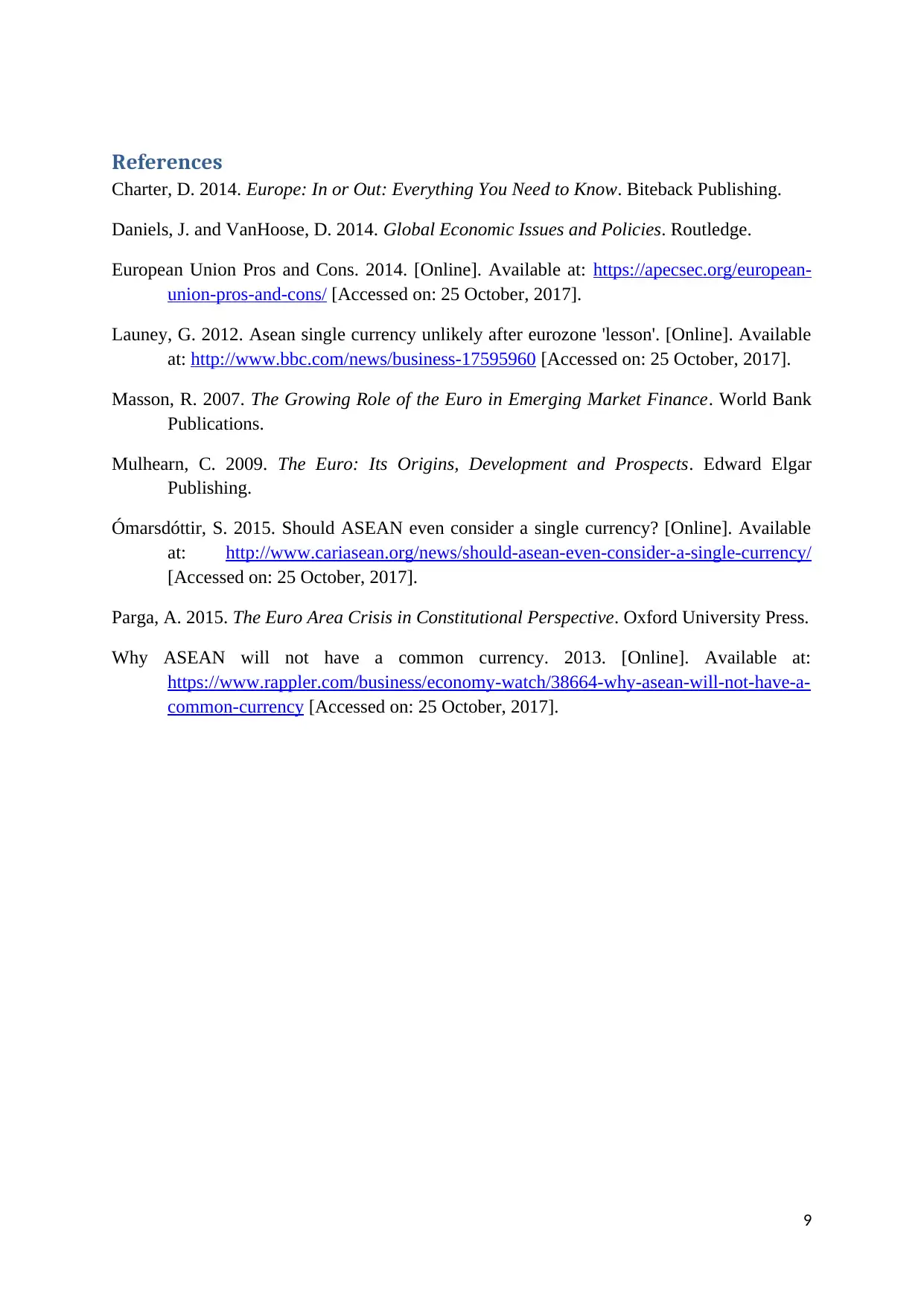
References
Charter, D. 2014. Europe: In or Out: Everything You Need to Know. Biteback Publishing.
Daniels, J. and VanHoose, D. 2014. Global Economic Issues and Policies. Routledge.
European Union Pros and Cons. 2014. [Online]. Available at: https://apecsec.org/european-
union-pros-and-cons/ [Accessed on: 25 October, 2017].
Launey, G. 2012. Asean single currency unlikely after eurozone 'lesson'. [Online]. Available
at: http://www.bbc.com/news/business-17595960 [Accessed on: 25 October, 2017].
Masson, R. 2007. The Growing Role of the Euro in Emerging Market Finance. World Bank
Publications.
Mulhearn, C. 2009. The Euro: Its Origins, Development and Prospects. Edward Elgar
Publishing.
Ómarsdóttir, S. 2015. Should ASEAN even consider a single currency? [Online]. Available
at: http://www.cariasean.org/news/should-asean-even-consider-a-single-currency/
[Accessed on: 25 October, 2017].
Parga, A. 2015. The Euro Area Crisis in Constitutional Perspective. Oxford University Press.
Why ASEAN will not have a common currency. 2013. [Online]. Available at:
https://www.rappler.com/business/economy-watch/38664-why-asean-will-not-have-a-
common-currency [Accessed on: 25 October, 2017].
9
Charter, D. 2014. Europe: In or Out: Everything You Need to Know. Biteback Publishing.
Daniels, J. and VanHoose, D. 2014. Global Economic Issues and Policies. Routledge.
European Union Pros and Cons. 2014. [Online]. Available at: https://apecsec.org/european-
union-pros-and-cons/ [Accessed on: 25 October, 2017].
Launey, G. 2012. Asean single currency unlikely after eurozone 'lesson'. [Online]. Available
at: http://www.bbc.com/news/business-17595960 [Accessed on: 25 October, 2017].
Masson, R. 2007. The Growing Role of the Euro in Emerging Market Finance. World Bank
Publications.
Mulhearn, C. 2009. The Euro: Its Origins, Development and Prospects. Edward Elgar
Publishing.
Ómarsdóttir, S. 2015. Should ASEAN even consider a single currency? [Online]. Available
at: http://www.cariasean.org/news/should-asean-even-consider-a-single-currency/
[Accessed on: 25 October, 2017].
Parga, A. 2015. The Euro Area Crisis in Constitutional Perspective. Oxford University Press.
Why ASEAN will not have a common currency. 2013. [Online]. Available at:
https://www.rappler.com/business/economy-watch/38664-why-asean-will-not-have-a-
common-currency [Accessed on: 25 October, 2017].
9
⊘ This is a preview!⊘
Do you want full access?
Subscribe today to unlock all pages.

Trusted by 1+ million students worldwide
1 out of 9
Related Documents
Your All-in-One AI-Powered Toolkit for Academic Success.
+13062052269
info@desklib.com
Available 24*7 on WhatsApp / Email
![[object Object]](/_next/static/media/star-bottom.7253800d.svg)
Unlock your academic potential
Copyright © 2020–2025 A2Z Services. All Rights Reserved. Developed and managed by ZUCOL.





